The Wireless Patient Monitoring Market is estimated to be valued at USD 183.2 billion in 2025 and is projected to reach USD 1574.7 billion by 2035, registering a compound annual growth rate (CAGR) of 24.0% over the forecast period.
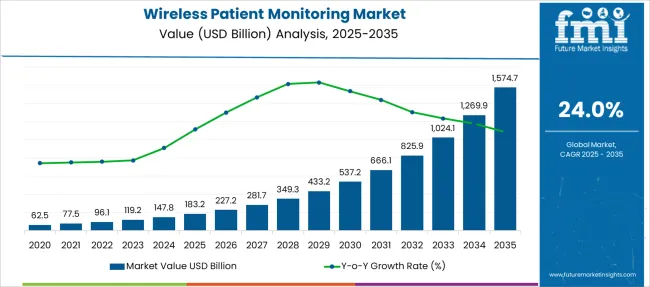
| Metric | Value |
|---|---|
| Wireless Patient Monitoring Market Estimated Value in (2025 E) | USD 183.2 billion |
| Wireless Patient Monitoring Market Forecast Value in (2035 F) | USD 1574.7 billion |
| Forecast CAGR (2025 to 2035) | 24.0% |
The wireless patient monitoring market is witnessing strong growth driven by increasing demand for remote healthcare services, rising chronic disease prevalence, and the growing shift toward value based care. Technological advancements in wearable sensors, mobile health applications, and real time data transmission have enabled seamless patient monitoring beyond traditional clinical settings.
Healthcare systems are increasingly investing in wireless monitoring solutions to reduce hospital readmissions, optimize patient outcomes, and improve workflow efficiency. Regulatory support for telehealth services and the rising elderly population further contribute to market expansion.
As healthcare providers seek scalable solutions that enhance patient engagement and clinical oversight, wireless monitoring technologies are becoming integral to long term care strategies across primary, acute, and home care environments.
The market is segmented by Product Type, Application Type, and End User and region. By Product Type, the market is divided into Cardiac Monitoring Devices, ECG Monitoring, BP Monitors, Heart Rate Monitors, Fetal Heart Rate Monitor, Respiratory Monitoring Devices, Respiration Rate Monitor, Spirometers, Sleep Apnea Monitor, Hematological Monitors, Blood Glucose Monitor, Prothrombin Time Monitor, and Multi-sign Monitors. In terms of Application Type, the market is classified into Asthma Monitoring, Chronic Obstructive Pulmonary Disease Monitoring, Congestive Heart Failure Monitoring Device, Coronary Heart Disease Monitoring Device, Cancer Monitoring Device, Diabetes Monitoring Device, and Other Disease Monitoring. Based on End User, the market is segmented into Hospitals, Home healthcare, Nursing homes, and Other (including first responders, institutional, physician offices, and military). Regionally, the market is classified into North America, Latin America, Western Europe, Eastern Europe, Balkan & Baltic Countries, Russia & Belarus, Central Asia, East Asia, South Asia & Pacific, and the Middle East & Africa.
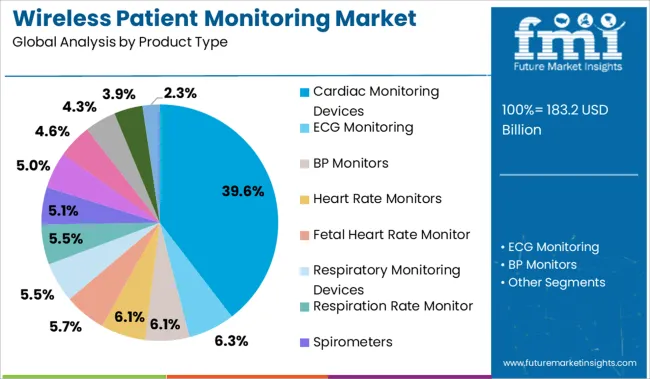
Cardiac monitoring devices are expected to account for 39.60% of total revenue by 2025 within the product type category, emerging as the leading segment. This dominance is attributed to the high global burden of cardiovascular diseases and the clinical need for continuous heart rhythm assessment.
Wireless cardiac monitors offer real time alerts, remote diagnostics, and integration with electronic health systems, making them essential tools for both preventive and post operative cardiac care. The ability to collect and transmit electrocardiographic data remotely enhances early intervention and improves care coordination.
These devices are increasingly adopted in outpatient and home care settings, reinforcing their market leadership within the product segment.
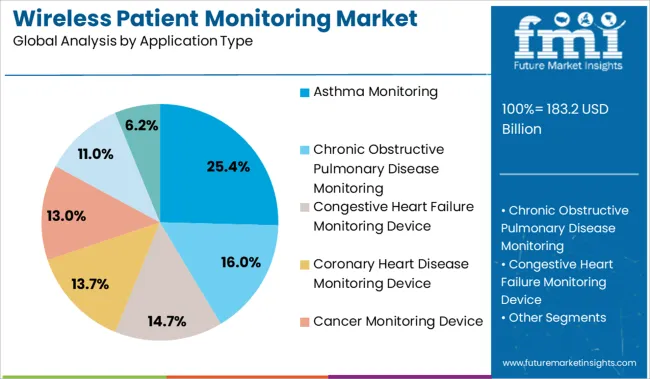
The asthma monitoring segment is projected to hold 25.40% of total market revenue by 2025 within the application type category, making it a key area of focus. This is driven by the rising global incidence of respiratory disorders and the need for proactive disease management in both pediatric and adult populations.
Wireless asthma monitors provide continuous tracking of respiratory patterns, medication adherence, and environmental triggers. They enable personalized interventions, helping reduce emergency visits and hospitalizations.
The integration of smart inhalers and mobile apps has improved disease awareness and patient self management, leading to wider adoption of asthma specific monitoring solutions and establishing this segment as a major contributor to overall market growth.
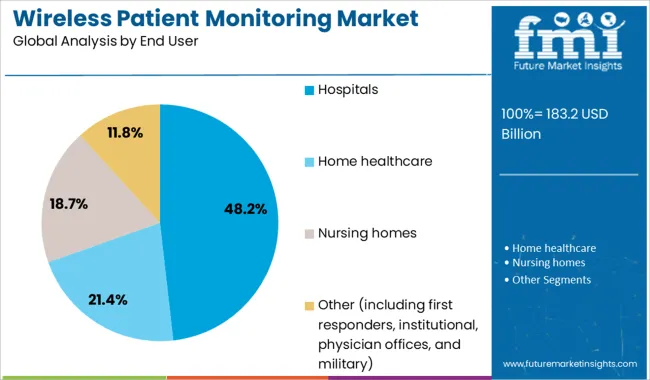
Hospitals are expected to represent 48.20% of total revenue by 2025 under the end user category, making them the dominant segment. The preference for wireless monitoring technologies in hospital environments is being fueled by the need for real time clinical decision making, patient mobility, and infection control.
These solutions help reduce in person monitoring requirements while enhancing care delivery through centralized dashboards and automated alerts. Wireless monitoring is widely implemented in intensive care units, cardiac wards, and emergency departments where timely intervention is critical.
The ability to monitor multiple patients simultaneously with minimal contact has further accelerated adoption in high acuity settings. As hospitals continue to prioritize technology enabled care models, their reliance on wireless patient monitoring systems is expected to grow substantially.
There are large number of patient pool prefer to manage health checkup from remote place, increase in the health awareness, the technological advancements in data recording for a longer period of time, therapeutic treatment and growing incidence of cardiovascular disease led to the increase in Wireless Patient Monitoring Systems.
The drawback for the Wireless Patient Monitoring Systems is the high cost, lack of uniform reimbursement.
The Global Wireless Patient Monitoring Systems market is expected to expand at healthy CAGR owing to increasing adoption of the products across the world. Among end users, hospital end user segment is expected to account for maximum share due to a requirement of advanced healthcare infrastructure and low cost.
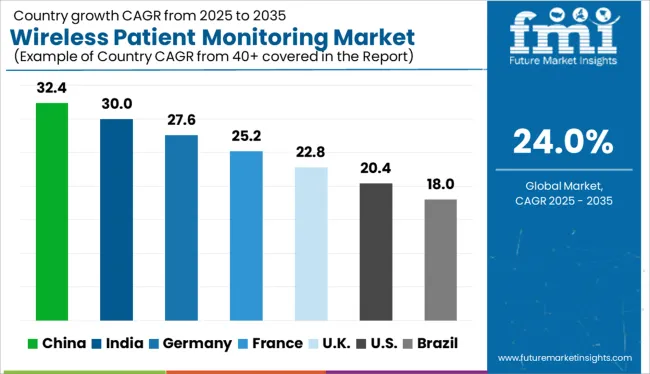
Geographically, the global wireless patient monitoring systems market is classified into regions namely, North America, Latin America, Western Europe, Eastern Europe, Asia-Pacific, Japan, Middle East and Africa. Among all the regions, North America will continue to lead the global market for wireless patient monitoring systems due to high purchasing power.
Asia- Pacific is expected to account for the second largest share in the global market primarily due to increasing number of medical interventions. A regional overview can be a directly proportional to the population.
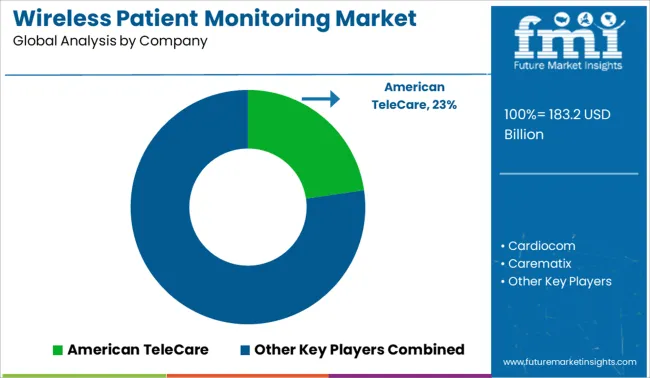
Key players operating in the global Wireless Patient Monitoring Systems are American TeleCare, Cardiocom, Carematix, Cybernet Medical Corporation, Drager Medical, GE Healthcare, GlobalMedia Group, Honeywell HomMed.
The research report presents a comprehensive assessment of the market and contains thoughtful insights, facts, historical data, and statistically supported and industry-validated market data. It also contains projections using a suitable set of assumptions and methodologies.
The research report provides analysis and information according to categories such as market segments, geographies, type of product and applications.
The global wireless patient monitoring market is estimated to be valued at USD 183.2 billion in 2025.
The market size for the wireless patient monitoring market is projected to reach USD 1,574.7 billion by 2035.
The wireless patient monitoring market is expected to grow at a 24.0% CAGR between 2025 and 2035.
The key product types in wireless patient monitoring market are cardiac monitoring devices, ecg monitoring, bp monitors, heart rate monitors, fetal heart rate monitor, respiratory monitoring devices, respiration rate monitor, spirometers, sleep apnea monitor, hematological monitors, blood glucose monitor, prothrombin time monitor and multi-sign monitors.
In terms of application type, asthma monitoring segment to command 25.4% share in the wireless patient monitoring market in 2025.






Full Research Suite comprises of:
Market outlook & trends analysis
Interviews & case studies
Strategic recommendations
Vendor profiles & capabilities analysis
5-year forecasts
8 regions and 60+ country-level data splits
Market segment data splits
12 months of continuous data updates
DELIVERED AS:
PDF EXCEL ONLINE
Wireless Refrigerant Charging Scale Market Size and Share Forecast Outlook 2025 to 2035
Wireless Hydrometer Market Size and Share Forecast Outlook 2025 to 2035
Wireless HDMI Transmitter and Receiver Market Size and Share Forecast Outlook 2025 to 2035
Wireless Access Point Market Size and Share Forecast Outlook 2025 to 2035
Wireless Video - 2.4/5GHz Market Size and Share Forecast Outlook 2025 to 2035
Wireless Polysomnography Market Size and Share Forecast Outlook 2025 to 2035
Wireless Audio Devices Market Size and Share Forecast Outlook 2025 to 2035
Wireless Communication Technologies In Healthcare Market Size and Share Forecast Outlook 2025 to 2035
Wireless Mesh Network Market Size and Share Forecast Outlook 2025 to 2035
Wireless Sensor Tags Market Size and Share Forecast Outlook 2025 to 2035
Wireless Sensor Network Market Size and Share Forecast Outlook 2025 to 2035
Wireless Power Transmission Market Size and Share Forecast Outlook 2025 to 2035
Wireless Home Security Camera Market Size and Share Forecast Outlook 2025 to 2035
Wireless Testing Market Size and Share Forecast Outlook 2025 to 2035
Wireless Power Bank Market Size and Share Forecast Outlook 2025 to 2035
Wireless Printer Market Size and Share Forecast Outlook 2025 to 2035
Wireless Headphones Market Size and Share Forecast Outlook 2025 to 2035
Wireless Sensors Market Size and Share Forecast Outlook 2025 to 2035
Wireless Display Market Size and Share Forecast Outlook 2025 to 2035
Wireless Paging Systems Market Size and Share Forecast Outlook 2025 to 2035

Thank you!
You will receive an email from our Business Development Manager. Please be sure to check your SPAM/JUNK folder too.
Chat With
MaRIA